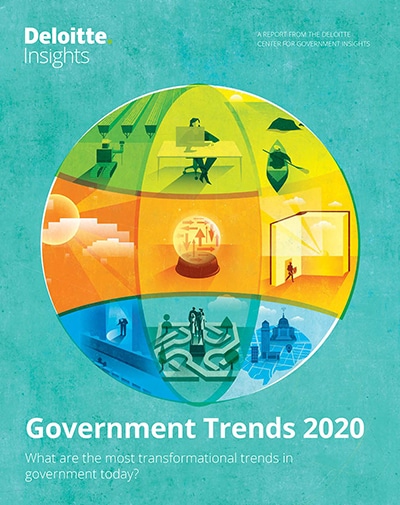
Introduction What are the most transformational trends in government today?
6 minute read
24 June 2019
How is government adapting to the unprecedented changes reshaping our world? As it works toward becoming more integrated and intuitive, here are nine of the most transformative trends in government today.
How is government adapting to the unprecedented changes reshaping our world? How can public officials navigate the tech tsunami? What can be done to ensure that democratic government, an institution designed to limit rapid change, can continue to fulfill its mission in the midst of a rapidly changing environment?
We are now entering what the World Economic Forum has termed the Fourth Industrial Revolution. With stunning expected technological advances on the horizon, it could be one of the momentous times in human history, akin to the invention of the printing press, the steam engine, the automobile, and vaccines.
When these innovations took place in the private sector, they reverberated in the public sector as well. Big changes outside government prompted new forms of government, adaptive changes appropriate for the times. We need a similar adaptive response today.
In a world of constant change, governments will need to be more intuitive, to sense and respond to new technology opportunities, social challenges, and citizen needs as they emerge. And to serve citizens well, governments will need to be more integrated. Breaking down silos and seamlessly connecting and streamlining data and process flows are integral to finding new solutions, enhancing security, and creating personalized and engaging citizen experiences. In short, transformation will require uprooting outdated systems and practices and replacing them with new models better suited to the age of artificial intelligence (AI).
The future is arriving in a blur, and we have no crystal ball. But we know that fundamental shifts—as momentous as the shifts of the progressive era—are starting and likely to accelerate in the years to come.
Since our launch nearly three years ago, the Deloitte Center for Government Insights has been researching and writing about the changes coming to government agencies that will fundamentally transform government. Over the course of this time, we have published more than 150 in-depth studies, exploring dozens of topics, ranging from the future of regulation to the impact of blockchain and other emerging technologies in the public sector. This large body of work is informed by the work in the trenches Deloitte does with governments all over the world to solve vexing problems amidst massive constraints. Together with our horizon scanning capabilities, this has given us wide visibility into the major trends and innovations impacting governments around the world.
The Government Trends 2020 report distills our research to focus on nine of the most transformative trends in government today. It is designed to assist government leaders who see the necessity for change and are looking for innovative ideas for the best way forward.
The nine government transformation trends
The nine trends we highlighted in this report have three things in common.
First, the trends all focus on government operations, as opposed to policy issues such as immigration or health care.
Second, each trend has moved beyond pilots and experiments and has begun to penetrate into the heart of government.
Third, they are all global in scope, happening in both developing and more economically advanced nations as more and more emerging-market governments leapfrog over yesterday’s legacy IT systems straight to more agile, digital-age models, such as cloud computing and cognitive technologies.
Understanding these trends is the first step in navigating the journey ahead.
AI-augmented government: Climbing the AI maturity curve. Cognitive technologies that are upending the consumer world are coming to a government near you. The way governments respond to AI, both as a regulator and as a user, will shape our societies and even geopolitics for years to come. State of play: Applications are beginning to be deployed, and the technology is improving rapidly. Both government and the private sector are adapting to the new possibilities.
Digital citizen: Improving end-to-end public service delivery via a unique digital identity. Unique digital identifiers open the door to integrated data and a seamless citizen experience, enabling dramatic leaps in service quality, massive efficiency gains, and the move to a digital delivery model. State of play: This trend is beginning to disperse. Mature digital authentication technologies in the private sector are starting to hit some governments—Estonia, India, and EU countries are leaders—but are lagging in parts of the world such as North America.
Nudging citizens for good: Using behavioral science to improve government outcomes. As the field of behavioral economics advances our understanding of how people make choices, “nudging” is replacing incentives and punishments—promising lower costs, better outcomes, and an enduring respect for human autonomy. State of play: Nudge units have been established in 200 governments worldwide, but there is still a huge number of untapped opportunities.
The rise of data and AI ethics: Managing the ethical complexities of the age of big data. Information is power, and power can be used for good or ill. Governments will play a major role in the rise of data ethics, not only as the “owner” of massive amounts of data but also as a regulator of corporate data use. As smart machines know more about us, we need to ensure that privacy, equity, and transparency guide their operations. Is your algorithm ethical? It should be. State of play: Across the world, from Canada to China, governments are passing laws, establishing task forces and specialized ethics units, and scrutinizing their own algorithms for biases. The private sector is also deeply engaged in collaborative efforts.
Anticipatory government: Preempting problems through predictive analytics. Data analytics, scenarios, and simulations allow us to target likely problems before they erupt. From spotting fraud to combatting the opioid epidemic, an ounce of prevention really is worth a pound of cure, especially in government. State of play: Emerging across many areas of government, from social services to food safety to law enforcement. The challenge is to change ways of working to fully take advantage of these new capabilities.
Cloud as innovation driver: The foundation for employing emerging technologies in government. Cloud computing is already a key enabler for other innovative trends (for example, nearly 87 percent of companies using AI do so in the cloud). It offers enormous leapfrog opportunities for governments in developing countries. And because cloud provides a mechanism to connect technology developers and users, its role as a foundation for innovation will only become more important (almost 50 percent of new software today is developed only in the cloud). State of play: While cloud adoption is growing rapidly, many public sector organizations struggle to realize its full potential.
Innovation accelerators: Creating safe spaces for government innovation. Iterative, reality-tested, safe experimentation is critical to innovation, in everything from health care to currency. Accelerators, incubators, and government “labs” are part of the emerging trend. In addition, regulatory sandboxes are a way to allow private innovations much greater flexibility within a limited space. State of play: This trend is growing rapidly. Some of the innovation units focus on “spinning in” promising solutions and adapting them as needed to a public sector context. Others focus on developing solutions in-house.
Smart government: Smart city solutions for the public services landscape. As we see with smart cities, integrated, connected, and sustainable governments will deploy technology to serve citizens in a collaborative and comprehensive manner, improving everything from mobility to health care to the environment. Cities are at the forefront of the trend, but it is now coming to regions, universities, military bases, and rural communities, among others. State of play: Early adoption is scattered across the world, with governance and funding (not technology) representing the largest constraints.
Citizen experience in government takes center stage: Treating citizens like customers to drive triple value impact. How can large public systems deliver services that meet the needs of individuals? They can start by walking in citizens’ shoes and understanding that “one size fits all” won’t cut it. Customer experience (Cx) tools can be effectively used to serve not just government’s customers but also government employees, regulated entities, and businesses. State of play: The approach is growing but still being narrowly deployed in government; the trend is more advanced in the private sector.
Explore the collection
-
The rise of data and AI ethics Article5 years ago
-
The digital citizen Article5 years ago
-
AI-augmented government Article5 years ago
-
Anticipatory government Article5 years ago
-
Cloud as innovation driver Article5 years ago
-
Government Trends 2024 Article7 months ago















